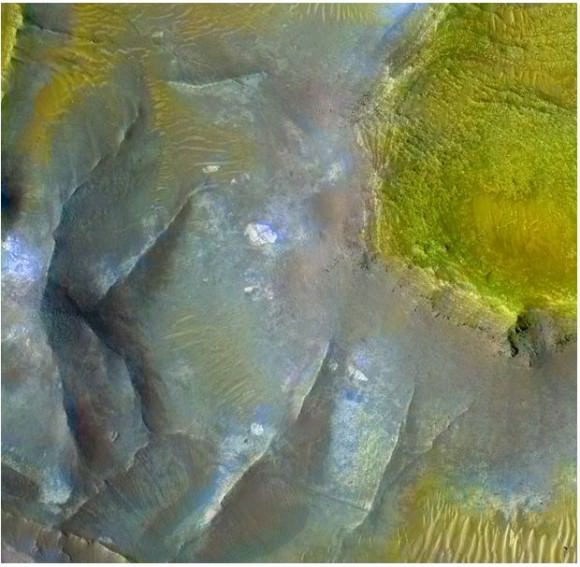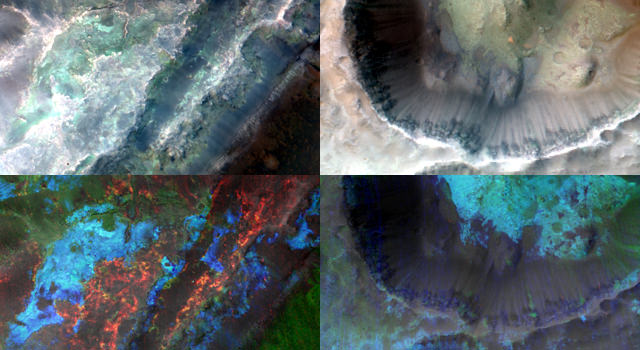[/caption]
Mars’ surface was probably not ever warm and wet long enough to support life, a new study published today in Nature concludes. But underground on the Red Planet might be a different story. By taking a look at several years of data from orbiting spacecraft and examining more than 350 sites on Mars, a team of researchers determined that Martian environments with abundant liquid water on the surface existed only in short episodes. But liquid and likely warm water more likely lasted for longer periods of time below the surface, and this would have been occurring at about the same time that life was developing on Earth.
“If surface habitats were short-term, that doesn’t mean we should be glum about prospects for life on Mars, but it says something about what type of environment we might want to look in,” said Bethany Ehlmann from Caltech and JPL, who is the lead author of the study. “The most stable Mars habitats over long durations appear to have been in the subsurface. On Earth, underground geothermal environments have active ecosystems.”
And so, the best place to look for signs of past life on Mars may be underground.
The researchers’ findings seem to indicate that Mars’ surface was almost always cold and dry, and any appearances of water – and the salts they left behind – occurred during geologically brief periods. This is certainly not the first time research has suggested brief periods of water flowing on Mars, or that underground water may have persisted, but the news study does help to provide a better picture of the history of water on Mars and even if it could possibly be there today.
Clays are crucial to understanding past water on Mars, as they form only when water is around long enough to change the chemical structure of rocks into clay, and different types of clay minerals result from different types of wet conditions.

In 2005, clay minerals were discovered in many regions of Mars by the OMEGA spectrometer on the ESA’s Mars Express. This finding seemed to indicate the planet was once warm and wet. But there’s a problem with Mars’ atmosphere – it is not thick enough now for water to be retained on Mars’ surface, and there is not scientific consensus that it was ever thick enough in the past to have allowed water to remain on the surface.
But this new study supports an alternative hypothesis that warm water persisted under Mars surface and many erosional features seen by the orbiting spacecraft were carved during brief periods when liquid water was stable at the surface.
“The types of clay minerals that formed in the shallow subsurface are all over Mars,” said John Mustard, professor at Brown University in Providence, R.I. Mustard a co-author of the study. “The types that formed on the surface are found at very limited locations and are quite rare.”
During the past five years, researchers used OMEGA and NASA’s Compact Reconnaissance Imaging Spectrometer, or CRISM, instrument on the Mars Reconnaissance Orbiter to identify clay minerals at thousands of locations on Mars. Clay minerals that form with small amounts of water usually retain the same chemical elements as those found in the original volcanic rocks later altered by the water.
The study interprets this to be the case for most terrains on Mars with iron and magnesium clays. In contrast, surface environments with higher ratios of water to rock can alter rocks further. Soluble elements are carried off by water, and different aluminum-rich clays form.
Another clue is detection of a mineral called prehnite. It forms at temperatures above about 400 degrees Fahrenheit (about 200 degrees Celsius). These temperatures are typical of underground hydrothermal environments rather than surface waters.
Two upcoming missions will help decipher the water clues left behind on Mars. The Curiosity rover, or the Mars Science Laboratory will be heading towards Gale Crater, to investigate a large, layered hill that contain clay and sulfate minerals. Curiosity is scheduled to launch later this month.
These new findings also have implications for how Mars’ atmosphere may have evolved over time, and the Mars Atmosphere and Volatile Evolution Mission, or MAVEN, in development for a 2013 launch, may provide evidence for or against this new interpretation of the Red Planet’s environmental history. This new study predicts MAVEN findings will beconsistent with the atmosphere not having been thick enough to provide warm, wet surface conditions for a prolonged period.
Source: JPL


…yet across the gulf of space, no minds that are to our minds as ours are to those of the beasts that perish, no intellects vast and cool and unsympathetic, regarded this earth with envious eyes, and slowly and surely did not draw any plans against us.
H.G.Wells (rejected draft)
There is an interesting article at New Scientist on the quantum mechanics of water
http://www.newscientist.com/article/mg21228354.900-waters-quantum-weirdness-makes-life-possible.html
This gives some reason to think that H_2O is the cosmic life medium. Speculations about life on Titan with liquid methane and the rest are to my mind problematic.
Water must be in the liquid form to support life. Clearly the Martian surface environment is impossible, for the atmospheric pressure is 1/100 that on Earth and the surface is subjected to solar UV radiation and charged particle radiation from CMEs. Water in subsurface conditions can be liquid and geological activity may provide the energy flow required to drive molecular biological processes. The subsurface conditions probably include layers of ice, where at the surface the ionic interaction with ice near sublimation or melting temperatures could result in a layer of liquid. Recent photographic evidence of water plumes flowing out of crater rims strongly suggests something like this is happening.
Mars has surface temperatures comparable to dry ice, which is pretty cold and not biologically sustainable. Jupiter and Saturn have moons with liquid nitrogen temperatures. Neptune and Uranus provide surface temperatures on moons with solid nitrogen temperatures. Things get pretty cold out there. Maybe Europa and Enceladus have interior temperatures and energy flow capable of driving biological processes. I have some reservations about these ideas though.
LC
– We should be careful to recognize that these are no longer mere speculations.
Hypotheses of biogenic processes predicts the Titan surface sink of hydrogen (which no known atmospheric process can predict) and the surface source of acetylene both. Hypotheses of abiogenic cold catalysts do the same, but alternate hypotheses aren’t a problem as such for predictivity.
Similarly hypotheses of liquid methane metabolism predicts such biogenic processes. As unlikely as they may be, these things have gone from dataless speculation to datadriven hypotheses.
– Mars has access to liquid water observed as brines, tentatively on and (IIRC) around the Phoenix lander. And as you note, other evidence suggests the same.
Considering the relatively vast and continuing water supply compared to other putative early environmental solvents, it is unlikely that any life would use other solvents.
– “Maybe Europa and Enceladus have interior temperatures and energy flow capable of driving biological processes.”
It is likely abiogenesis happens by chemical selection in a thermal gradient, over time as a planet or planetesimal cools, or locally over space as hydrothermal flows circulate.
Mature cellular life can make do on the energy of radioactive ores alone, using liberated hydrogen as redox source and sulfur as redox electron sink.
[The much hyped hydrothermal vent ecologies are not independent of photosynthesis I think, as many or most of their species likely ultimately rely on oxygen as redox electron sink.* It is available, and it gets more energy out of the local environment.]
The problem then is early cellular life. On Mars it could feasibly evolve to the more robust and multi-functional cells or communities that endure living in crusts on available chemical energy sources. (Sources ultimately originating from radioactive or thermal sources.) Mars could have had a Goldilocks period of temporary access to the surface and thus to photosynthesis to have opportunity to evolve towards sturdier metabolisms.
It is a much harder proposition to have that happen in the blackened depths of ice-covered oceans.
————
* Disclaimer: I haven’t tried to test that hypothesis as of yet.
Are there ANY active volcanic features on Mars today?
Do we even find any warm areas that belie activity below?
Seems like old, cold and dry crust with not even the barest puff of steam in the caldera of any of the old volcanoes.
Luckily, we, or at least I, have little to no worries on that account. The martian meteorite shergottites shows a continuous igneous supply from ~ 4 Ga bp to ~ 180 Ma bp. This is why we see those largish martian shield volcanoes btw.
Even if some questions the dating on likelihood, it is precisely the highest likelihood and simplest hypothesis that igneous processes continued to modern times and are still working today. One source of putative observed methane would also be igneous processes.
This is inconsistent with the predictions of shorelines from vast waters, most prominently a northern ocean. But the set of consistent observations would make this the stronger hypothesis. Hopefully MAVEN will sort this out.
As for the astrobiological side, a biosphere without photosynthesis means a low powered prokaryotic one. Even, I think, if they in this case can use available oxygen instead of sulfur as redox electron sink.
Also, it potentially undercuts the biosphere usability of putative methane finds. Methanogenic pathways on Earth evolved after the Great Oxygen Event out of an aerobic pathway of methylophiles. Perhaps other biospheres can shortcut that, the potential is there I guess.
But if not the methane is abiogenic and only usable by methanophiles. (Which here evolved from another, anaerobic, pathway.)